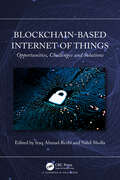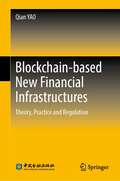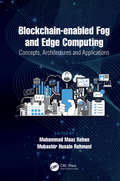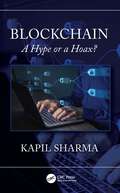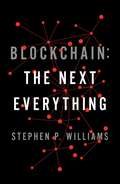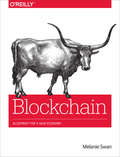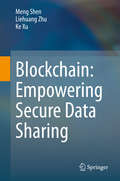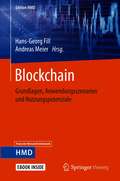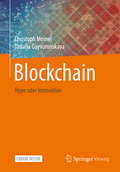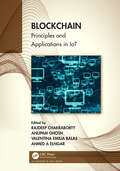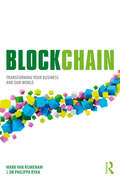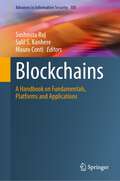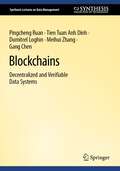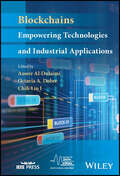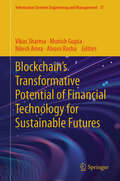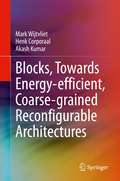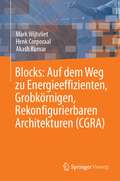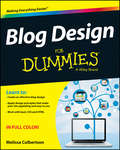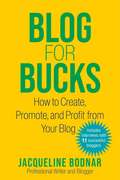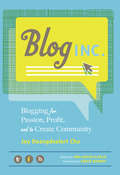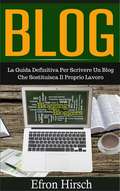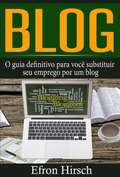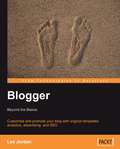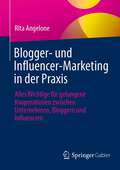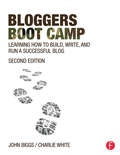- Table View
- List View
Blockchain-based Internet of Things: Opportunities, Challenges and Solutions
by Iraq Ahmad Reshi Sahil ShollaThis book presents an overview of the blockchain-based Internet of Things systems, along with the opportunities, challenges, and solutions in diverse fields such as business, education, agriculture, and healthcare. It discusses scalability, security, layers, threats, and countermeasures in blockchain-based Internet of Things network.· Elaborates on the opportunities presented by combining blockchain with artificial intelligence on the Internet of Things systems in the management of food systems, and drug supply chains.· Explains the management of computationally intensive tasks in blockchain-based Internet of Things through the development of lightweight protocols.· Presents various applications in fields including logistics and the supply chain, automobile industry, smart housing, shared economy, and agriculture.· Provides insights into blockchain-based Internet of Things systems, along with their features, vulnerabilities, and architectural flaws.· The text is primarily written for graduate students, and academic researchers working in the fields of computer science and engineering, electrical engineering, and information technology.
Blockchain-based New Financial Infrastructures: Theory, Practice and Regulation
by Qian YAOThis book focuses on development of blockchain-based new-generation financial infrastructures, in which a systematic, complete theoretical framework is proposed to explore blockchain-based securities trading platform, central securities depository (CSD), securities settlement system (SSS), central counterparty (CCP), payment system (PS) and trade repository (TR). The blockchain-based new FMI has attracted much attention in the securities industry. At present, the cross-border depository receipt (DR) business faces a dilemma between efficiency and security. In this book, the author proposes a blockchain-based new DR solution, manifesting the potential for using blockchain technology in the FMI field. In addition, using Hashed Timelock Contract (HTLC) as the underlying technology in the DR scenario, specific process and operations are proposed for delivery versus payment (DvP), delivery versus delivery (DvD) or payment versus payment (PvP) and other exchange-of-value methods. This book further studies how to carry out opening positions, end-of-day settlement of margin, forced liquidation and settlement at maturity, for exchange-traded derivatives, such as futures and options, under the blockchain-based technological framework. Blockchain technology not only naturally fits into the decentralized or non-centralized characteristic of the OTC market but also can effectively address the pain points and difficulties of the OTC market. This book provides an in-depth analysis of existing specific issues in China’s bond market, regional equity markets and asset management market, among other OTC markets, and proposes relevant blockchain-based solutions. Blockchain technology does not change the public policy objectives for FMI. Theblockchain-based new FMIs are still subject to compliance, safety and efficiency requirements. This book provides a comprehensive assessment of the applicability of the Principles for Financial MarketInfrastructures (PFMI) to them, in particular, analyzes their legal basis, off-chain governance and system security.
Blockchain-enabled Fog and Edge Computing: Concepts, Architectures and Applications
by Mubashir Husain Rehmani Muhammad Maaz RehanThis comprehensive book unveils the working relationship of blockchain and the fog/edge computing. The contents of the book have been designed in such a way that the reader will not only understand blockchain and fog/edge computing but will also understand their co-existence and their collaborative power to solve a range of versatile problems. The first part of the book covers fundamental concepts and the applications of blockchain-enabled fog and edge computing. These include: Internet of Things, Tactile Internet, Smart City; and E-challan in the Internet of Vehicles. The second part of the book covers security and privacy related issues of blockchain-enabled fog and edge computing. These include, hardware primitive based Physical Unclonable Functions; Secure Management Systems; security of Edge and Cloud in the presence of blockchain; secure storage in fog using blockchain; and using differential privacy for edge-based Smart Grid over blockchain. This book is written for students, computer scientists, researchers and developers, who wish to work in the domain of blockchain and fog/edge computing. One of the unique features of this book is highlighting the issues, challenges, and future research directions associated with Blockchain-enabled fog and edge computing paradigm. We hope the readers will consider this book a valuable addition in the domain of Blockchain and fog/edge computing.
Blockchain: A Hype or a Hoax?
by Kapil SharmaBlockchain: A Hype or a Hoax? fills a gap in the book market to provide material that is not only technical but also caters to business readers. This book was written to keep in mind various stakeholders and the current gap in blockchain education as well as use case implementation. This book reviews blockchain technology, discusses why proof of concept fails, offers examples of use cases that have been successful and that have failed and articulates a framework that should be used before deciding whether blockchain is the right technology for transformation. It uses strategic models and frameworks to assist organisations to see a fit score for their specific use cases. This book provides guidance on how to create a blockchain strategy and a business case to pitch for the budget. It also includes a case study to apply the knowledge on practical use cases for blockchain and a technical overview of most of the blockchain use cases in the market including crypto, non-fungible tokens, decentralised finance, and decentralised autonomous organisations, as well as financial and non-financial industry use cases. This book also provides a detailed overview of most of the mainstream blockchain products currently available in the market. It also offers guidance on how readers can best educate themselves on blockchain technology that is available through commercial and free resources. It concludes with a clear direction on selecting blockchain to solve real-life use cases that are best fit. A financial and non-financial value-adding framework is discussed throughout this book to assist business leaders, programme managers, product managers and information technology leaders to make strategic choices, and business cases and develop strategies for digital transformation through the use of blockchain. The distinctive feature of this book is the critical analysis of blockchain from a technology and business perspective. This is the first book to focus on business, technology and blockchain selection framework. The most unique feature of this book would be to apply Michael Porter’s competitive advantage strategy theory on blockchain use cases and their impact on companies. This book is aimed at technology students, technology professionals, blockchain and fintech consultant and business leaders. It will also be useful for readers who are building a business case to adopt blockchain into an organisation or are seeking to grow their knowledge of blockchain and improve their fintech strategy.
Blockchain: A Short Guide To Blockchain
by Stephen P. WilliamsAn experienced tech writer fully explains blockchain technology and how it will radically transform the world as we know it in this accessible, reader-friendly, illuminating guide.What is blockchain? Why does everyone from tech experts to business moguls to philanthropists believe it is a paradigm-shifting technology, bound to revolutionize society as significantly as the internet? Indeed, why is blockchain touted as The Next Everything? In this deft, fascinating, and easy-to-digest introduction to one of the most important innovations of recent times, Stephen P. Williams answers these questions, revealing how cryptocurrencies like bitcoin are just one example among dozens of transformative applications that this relatively new technology makes possible. He interprets the complexity into digestible anecdotes, metaphors, and straightforward descriptions for readers who don’t know tech, and explains all of blockchain’s most important aspects: why this so-called digital ledger is unhackable and unchangeable; how its distributed nature may transfer power from central entities like banks, government, and corporations to ordinary citizens around the world; and what its widespread use will mean for society as a whole. Taking us on a dazzlingly vivid tour through the systems predicted to soon underpin economics, politics, global trade, science, art, and numerous other aspects of our everyday lives, Blockchain: The Next Everything is a truly extraordinary journey into our future.
Blockchain: Blueprint for a New Economy
by Melanie SwanBitcoin is starting to come into its own as a digital currency, but the blockchain technology behind it could prove to be much more significant. This book takes you beyond the currency ("Blockchain 1.0") and smart contracts ("Blockchain 2.0") to demonstrate how the blockchain is in position to become the fifth disruptive computing paradigm after mainframes, PCs, the Internet, and mobile/social networking.Author Melanie Swan, Founder of the Institute for Blockchain Studies, explains that the blockchain is essentially a public ledger with potential as a worldwide, decentralized record for the registration, inventory, and transfer of all assets—not just finances, but property and intangible assets such as votes, software, health data, and ideas.Topics include:Concepts, features, and functionality of Bitcoin and the blockchainUsing the blockchain for automated tracking of all digital endeavorsEnabling censorship?resistant organizational modelsCreating a decentralized digital repository to verify identityPossibility of cheaper, more efficient services traditionally provided by nationsBlockchain for science: making better use of the data-mining networkPersonal health record storage, including access to one’s own genomic dataOpen access academic publishing on the blockchainThis book is part of an ongoing O’Reilly series. Mastering Bitcoin: Unlocking Digital Crypto-Currencies introduces Bitcoin and describes the technology behind Bitcoin and the blockchain. Blockchain: Blueprint for a New Economy considers theoretical, philosophical, and societal impact of cryptocurrencies and blockchain technologies.
Blockchain: Empowering Secure Data Sharing
by Ke Xu Liehuang Zhu Meng ShenWith the development of big data, data sharing has become increasingly popular and important in optimizing resource allocation and improving information utilization. However, the expansion of data sharing means there is an urgent need to address the issue of the privacy protection – an area where the emerging blockchain technology offers considerable advantages. Although there are a large number of research papers on data sharing modeling and analysis of network security, there are few books dedicated to blockchain-based secure data sharing.Filing this gap in the literature, the book proposes a new data-sharing model based on the blockchain system, which is being increasingly used in medical and credit reporting contexts. It describes in detail various aspects of the model, including its role, transaction structure design, secure multi-party computing and homomorphic encryption services, and incentive mechanisms, and presents corresponding case studies. The book explains the security architecture model and the practice of building data sharing from the blockchain infrastructure, allowing readers to understand the importance of data sharing security based on the blockchain framework, as well as the threats to security and privacy. Further, by presenting specific data sharing case studies, it offers insights into solving data security sharing problems in more practical fields. The book is intended for readers with a basic understanding of the blockchain infrastructure, consensus mechanisms, smart contracts, secure multiparty computing, homomorphic encryption and image retrieval technologies.
Blockchain: Grundlagen, Anwendungsszenarien und Nutzungspotenziale (Edition HMD)
by Andreas Meier Hans-Georg FillSowohl in der Praxis als auch der wissenschaftlichen Forschung ist das Thema "Blockchain" aktuell von großem Interesse. Noch scheint sich die Technologie am Anfang ihrer Entwicklung zu befinden: Plattformen wie Bitcoin, Ethereum, Hyperledger Fabric, Libra, TradeLens oder andere weisen bereits einen beeindruckenden Reifegrad in ihrer technischen Entwicklung auf. Dennoch befinden sich erst wenige von ihnen bzw. darauf aufbauende Applikationen im produktiven Einsatz bei Unternehmen. Hier können nicht nur Forschende optimal dazu beitragen, neue Ideen zu entwickeln, noch nicht betrachtete Anwendungsfälle und -domänen zu untersuchen und erste Prototypen für den konkreten Einsatz zu entwickeln. Die Beiträge der vorliegenden Edition HMD bieten dazu einen umfassenden Überblick und zeigen die große Bandbreite an möglichen Anwendungsfeldern für Blockchains. Das Herausgeberwerk vermittelt somit die Grundlagen zur Blockchain-Technologie, widmet sich den Smart Contracts und beschreibt wichtige Anwendungsszenarien, erste Fallbeispiele und rechtliche Aspekte. Wie typisch für die Fachbuchreihe Edition HMD greifen die Beitragsautoren das Thema aus Sicht von Forschung und Praxis gleichermaßen auf. Ein Glossar mit den wichtigsten Begriffen rundet das Buch ab.
Blockchain: Hype oder Innovation
by Christoph Meinel Tatiana GayvoronskayaWer noch nie über Blockchain gehört hat, würde bestimmt das Buch gerade nicht in der Hand halten. Das Thema ist heiß diskutiert und hat bereits viele Befürworter sowie Gegner. In diesem Buch erwartet Sie eine klare und verständliche Erklärung der Blockchain-Technologie mit ausführlichen Erläuterungen zu deren Entstehung, Technik und Umsetzung. Damit möchten wir die Debatte um Blockchain-Hype versachlichen und Ihnen die Entscheidung überlassen, ob Blockchain für Sie tatsächlich ein Hype oder eine Innovation ist.
Blockchain: Principles and Applications in IoT
by Valentina Emilia Balas Ahmed A Elngar Rajdeep Chakraborty Anupam GhoshBlockchain: Principles and Applications in IoT covers all the aspects of Blockchain and its application in IOT. The book focuses on Blockchain, its features, and the core technologies that are used to build the Blockchain network. The gradual flow of chapters traces the history of blockchain from cryptocurrencies to blockchain technology platforms and applications that are adopted by mainstream financial and industrial domains worldwide due to their ease of use, increased security and transparency. • Focuses on application of Blockchain on IoT domain • Focuses on Blockchain as a data repository • Most books on Blockchain cover bitcoins and crypto currency. This book will also cover blockchain in other areas like healthcare, supply chain management, etc • Covers consensus algorithms like PAROX, RAFT etc. and its applications This book is primarily aimed at graduates and researchers in computer science and IT.
Blockchain: Transforming Your Business and Our World
by Mark Van Rijmenam Philippa RyanThe internet was envisaged as a decentralised global network, but in the past 25 years it has come to be controlled by a few, very powerful, centralised companies. Blockchain is a technological paradigm shift that allows secure, reliable, and direct information transfer between individuals, organisations, and things, so that we can manage, verify, and control the use of our own data. Blockchain also offers a new opportunity for humanity to fix some major problems. It can authenticate data, manage its analysis, and automate its use. With better data comes better decision-making. In this way, Blockchain can contribute to solving climate change, reduce voting fraud, fix our identity systems, improve fair trade, and give the poor an opportunity to improve their lives by monetising their (digital) capital. A world built upon peer-to-peer transactions and smart contracts can empower individuals and communities. This book offers a fresh perspective with which to consider this transformative technology. It describes how Blockchain can optimise the processes that run our society. It provides practical solutions to global problems and offers a roadmap to incorporate Blockchain in your business. It offers a blueprint for a better world. Filled with easy-to-understand examples, this book shows how Blockchain can take over where the internet has fallen short.
Blockchains: A Handbook on Fundamentals, Platforms and Applications (Advances in Information Security #105)
by Mauro Conti Sushmita Ruj Salil S. KanhereThis handbook is a selection of foundational aspects, security analysis, platforms, and applications of blockchains that consists of four parts. The first part introduces the basic building blocks such as distributed computing and cryptography. Consensus algorithms that form the basic backbone of blockchain protocols are presented. Various cryptographic tools like hash functions, digital signatures and commitment schemes are also introduced. Advanced cryptographic techniques such as zero knowledge protocols, secret sharing, verifiable random functions that are used for privacy-preserving and secure design are discussed. The second part of this handbook consists of popular blockchain designs and platforms. Architecture of Bitcoin, Ethereum, Monero, Tendermint and Algorand have been presented. Various important issues like scalability and security are discussed in the third part. Security design challenges, security vulnerabilities and their analysis are discussed. The final part of this handbook discusses various applications of blockchains. These include supply-chain, identity and credential management, Internet of Things (IoT), data-sharing, e-voting, e-governance, e-health, smart cities, and Industry 4.0. Research challenges and directions of future work are included in this handbook.This comprehensive reference targets students and researchers, who are starting to explore blockchain. Professionals working in blockchain security and applications will find this handbook to be a valuable reference.
Blockchains: Decentralized and Verifiable Data Systems (Synthesis Lectures on Data Management)
by Gang Chen Pingcheng Ruan Tien Tuan Dinh Dumitrel Loghin Meihui ZhangThis book takes readers through the sensational history of blockchains and their potential to revolutionize database systems of the future. In order to demystify blockchains, the book capitalizes on decades of research and field testing of existing database and distributed systems and applies these familiar concepts to the novel blockchain system. It then utilizes this framework to explore the essential block platform underpinning blockchains, which is often misunderstood as a specific attribute of cryptocurrencies rather than the core of the decentralized system independent of application. The book explores the nature of these decentralized systems, which have no single owner and build robustness through a multitude of stakeholder contributions. In this way, blockchains can build trust into existing systems and thus present attractive solutions for various domains across both academia and industry. Despite this, high-impact and real-world applications of blockchain have yet to be realized outside of cryptocurrencies like Bitcoin. The book establishes how this new data system, if properly applied, can disrupt the sector in much the same way databases did so many years ago. The book explores the fundamental technical limitations that may be preventing blockchain from realizing this potential and how to overcome or mitigate them. Readers who are completely new to blockchains will find this book to be a comprehensive survey of the state of the art in blockchain technology. Readers with some experience of blockchains, for example through developing cryptocurrencies, will likely find the book’s database perspective enlightening. Finally, researchers already working with blockchain will learn to identify existing gaps in the design space and explore potential solutions for creating the next generation of blockchain systems.
Blockchains: Empowering Technologies and Industrial Applications (IEEE Series on Digital & Mobile Communication)
by Anwer Al-Dulaimi Octavia A. Dobre Chih-Lin IBlockchains Empowering Technologies and Industrial Applications A comprehensive guide to the most recent developments in blockchains in theoretical and industrial perspectives Originally introduced as a method to keep track of Bitcoin transactions over a peer-to-peer network, blockchain is a continuously growing list of records, called blocks, which are linked and secured using cryptography into a chain held in public databases. The use of this technology has grown since its cryptocurrency creation and now store three types of information: 1) transactions, including the date, time, and value of purchases; 2) records of participates in transactions; and 3) unique code known as a “hash” that distinguishes one block from another. A single block on the blockchain can hold 1 MB of data, or potentially thousands of transactions — this then can allow for hundreds of thousands of transactions to be recorded as each block can join the state-of-the-art blockchain. Blockchains provides a detailed overview of the latest and most innovative concepts, techniques, and applications related to the developing blockchain. Aimed at novices and experts on the subject, the book focuses on blockchain technologies, integrated systems, and use cases, specifically by looking at three major technical areas: blockchain platforms and distributed database technologies, consensus and fault tolerance, and Blockchain as a Service (BaaS). These avenues of research are essential to support blockchain functionalities, such as acquiring and updating existing data, securing data resources and the recovery of failures, and using blockchains in various services that range from cryptocurrencies to cloud automation. Blockchains readers will also find: Brainstorming activities that gradually builds the knowledge of readers on the described technology and deployment scenarios Investigation of specific topics such as novel networking protocols, wireless techniques, new infrastructure designs, operations management, and deployment strategies Discussion of technical challenges in blockchain, as well as how to manage cloud-based networks, service automation, and cyber security Numerous elementary and advanced examples on various topics at the end of the book that can be used for training purposes Illustrations including tables and diagrams to help elucidate points made throughout the volume Glossary of relevant terminology to blockchains in enterprise Blockchains is a useful reference for researchers in vehicular networking and computer science, as well as cloud storage providers and governmental offices for data management.
Blockchain’s Transformative Potential of Financial Technology for Sustainable Futures (Information Systems Engineering and Management #17)
by Alvaro Rocha Vikas Sharma Munish Gupta Nilesh Arora"Blockchain's Transformative Potential of Financial Technology for Sustainable Futures" delves into the groundbreaking impact of blockchain technology on the financial sector, highlighting its potential to foster sustainable development. This comprehensive volume brings together a diverse array of experts who explore how blockchain can revolutionize financial technology (FinTech) by enhancing transparency, efficiency, and inclusivity. The book examines blockchain's role in promoting financial inclusion, providing secure and accessible financial services to underserved populations. By bridging gaps in the current financial system, blockchain empowers individuals and communities, driving economic growth and resilience. Additionally, it addresses the environmental benefits of blockchain, showcasing innovative solutions like decentralized energy markets and transparent supply chains that contribute to sustainability. Readers will gain insights into real-world applications of blockchain, supported by case studies and in-depth analyses. The book also navigates the complex regulatory and ethical landscape, offering guidance on harnessing blockchain's potential responsibly. "Blockchain's Transformative Potential of Financial Technology for Sustainable Futures" is an essential resource for professionals, researchers, and policymakers interested in the future of FinTech and sustainable development. It serves as a catalyst for further research, dialogue, and collaboration, inspiring a new era of financial innovation and sustainability.
Blocks, Towards Energy-efficient, Coarse-grained Reconfigurable Architectures
by Henk Corporaal Akash Kumar Mark WijtvlietThis book describes a new, coarse-grained reconfigurable architecture (CGRA), called Blocks, and puts it in the context of computer architectures, and in particular of other CGRAs. The book starts with an extensive evaluation of historic and existing CGRAs and their strengths and weaknesses. This also leads to a better understanding and new definition of what distinguishes CGRAs from other architectural approaches. The authors introduce Blocks as unique due to its separate programmable control and data paths, allowing light-weight instruction decode units to be arbitrarily connected to one or more functional units (FUs) over a statically configured interconnect. The discussion includes an explanation of how to model architectures, resulting in an area and energy model for Blocks. The accuracy of this model is evaluated against fully implemented architectures, showing that although it is three orders of magnitude faster than synthesis the error margin is very acceptable. The book concludes with a case study on a real System-on-Chip, including a RISC architecture, the Blocks CGRA and peripherals.
Blocks: Auf dem Weg zu Energieeffizienten, Grobkörnigen, Rekonfigurierbaren Architekturen (CGRA)
by Henk Corporaal Akash Kumar Mark WijtvlietDieses Buch beschreibt eine neue, grobkörnige rekonfigurierbare Architektur (CGRA), genannt Blocks, und stellt sie in den Kontext von Computerarchitekturen und insbesondere von anderen CGRAs. Das Buch beginnt mit einer ausführlichen Bewertung historischer und bestehender CGRAs und deren Stärken und Schwächen. Dies führt auch zu einem besseren Verständnis und einer neuen Definition dessen, was CGRAs von anderen Architekturansätzen unterscheidet. Die Autoren stellen Blocks als einzigartig vor, da es über separate programmierbare Steuer- und Datenpfade verfügt, so dass leichtgewichtige Befehlsdekodiereinheiten über eine statisch konfigurierte Verbindung beliebig mit einer oder mehreren Funktionseinheiten (FUs) verbunden werden können. In der Diskussion wird erläutert, wie Architekturen modelliert werden können, was zu einem Flächen- und Energiemodell für Blöcke führt. Die Genauigkeit dieses Modells wird anhand vollständig implementierter Architekturen bewertet, wobei sich zeigt, dass die Fehlerspanne sehr akzeptabel ist, obwohl es um drei Größenordnungen schneller ist als die Synthese. Das Buch schließt mit einer Fallstudie zu einem echten System-on-Chip, einschließlich einer RISC-Architektur, der Blocks CGRA und Peripheriegeräten.
Blog Design For Dummies
by Melissa CulbertsonThe average blogger does not typically have experience with design or coding, but that shouldn't deter them from having a professional-looking blog design. This friendly and easy-to-understand guide provides you with the tools you need to establish a creative, unique, and aesthetically memorable blog without having to learn how to code beyond some basic CSS. Whether you're looking to write for a major brand, become a brand ambassador, sell a product, acquire new clients, advocate for a cause, or simply tell a story, you'll find design tricks, helpful techniques, and invaluable advice for creating a great-looking and functional blog.Provides the tools you need to understand what makes a successful blog from a design standpointTeaches you CSS coding that can be used to create an effective blog design that gets noticedHelps you make design decisions regarding colors, fonts, and imageryPlaces special emphasis on providing your readers with a site that is easy to use thanks to smart navigationBlog Design For Dummies empowers you to make smart and creative adjustments to your blog so that you can be the proud owner of an effective blog design that gets noticed!
Blog for Bucks: How to Create, Promote, and Profit from Your Blog
by Jacqueline BodnarProven Advice for Running a Successful, Profitable Blog—from Writing and Organizing to Promoting and Monetizing Millions of people would love to make money from blogging, but they have no clue where to start and how to make it happen. It takes more than simply starting the blog, and this book will show you what you need to know. Jacqueline Bodnar, a professional writer and blogger shares her experience and knowledge, covering everything from how to generate blog post ideas to tracking your blog&’s success to connecting with other bloggers. Blog for Bucks includes chapters on topics such as: Blogging BasicsKeeping It ActiveAll About WritingWays to Promote Your BlogMonetizing Your BlogWays to Enhance Your BlogWhere Your Blog Can Take You Whether you are a new or seasoned blogger, there is information in this book that will help you take your blog to the next level. The invaluable information, advice, and insight will inspire you to get started, launch another blog, or get serious about making money from your current one. Don&’t miss out on the tried-and-true tips and methods in this book that will help you blog for bucks!
Blog, Inc.: Blogging for Passion, Profit, and to Create Community (Inc Ser.)
by Joy Deangdeelert Cho Meg Mateo Ilasco Grace BonneyWith roughly 95,000 blogs launched worldwide every 24 hours (BlogPulse), making a fledgling site stand out isn't easy. This authoritative handbook gives creative hopefuls a leg up. Joy Cho, of the award-winning Oh Joy!, offers expert advice on starting and growing a blog, from design and finance to overcoming blogger's block, attracting readers, and more. With a foreword from Grace Bonney of Design*Sponge plus expert interviews, this book will fine-tune what the next generation of bloggers shares with the world.
Blog: La Guida Definitiva Per Scrivere Un Blog Che Sostituisca Il Proprio Lavoro
by Stefania Pezzato Efron HirschUsate Questi Segreti per Blog per Creare un Blog Importante e Redditizio State cercando di creare un blog per fare soldi? Questo libro vi mostrerà cosa dovete fare per iniziare a tenere un blog remunerativo oggi stesso, basandosi su quello che fanno i migliori blogger. Se seguirete le istruzioni fornite avrete un bel blog che porta profitti in poco tempo! Ecco un anticipo di cosa imparerete... Come Creare un Blog Come Scegliere una Nicchia Come Progettare il Vostro Blog Come Iniziare a Creare i Post Come Creare Contenuti di Valore Come Generare Traffico Come Monetizzare il Vostro Blog E Molto, Molto Altro!
Blog: O guia definitivo para você substituir seu emprego por um blog
by Efron HirschVocê está tentando criar um blog lucrativo? Este livro sucesso de vendas nos Estados Unidos vai mostrar exatamente o que você precisa fazer para começar um blog lucrativo agora mesmo se baseando no que os maiores blogueiros estão fazendo. Se você seguir as instruções, terá um blog com um visual maravilhoso e bastante lucrativo bem rápido. Aqui está uma prévia do que você vai aprender a fazer: Como criar um blog Como escolher um nicho Como fazer o design do seu blog Como começar a criar posts Como criar um blog com conteúdo valioso Como gerar tráfego Como monetizar seu blog E muito, muito mais!
Blogger Beyond the Basics
by Lee JordanWritten in a clear, easy-to-read style, the book takes you through the essential tasks required to create a feature-rich blog as quickly as possible. From initial setup to customizing modules, each task is explained in a clear, practical way using an example blog developed through the book. You'll also learn how to market and measure the success of your blog using Google web applications and other popular tools. This book deals with using the current Blogger and third-party tools to optimize and create widgets for your blog. You'll transform your blog using existing tools then take it further with more challenging approaches to customizing your blog. All the steps involved in each example are listed under the section called "Time for action". Similarly, the results of that action are listed under the section called "What just happened". This structure adds to the clear, simple, and focused approach of the book. The book is aimed at current users of the Blogger platform who want to get the most out of Blogger and people who use a different blogging platform and are planning on switching to Blogger. Blog owners who promote their own services, expertise, and products, and want to increase their blog's success by pushing the limits of what Blogger can do will get the most out of this book. The book doesn't require any specific knowledge of Blogger or the related technologies: RSS, CSS, HTML, and XML. Everything you need to know to grow beyond the basics is covered in this book. The companion website to this book (http://bloggerbeefedup.blogspot.com) includes free resource images and content.
Blogger- und Influencer-Marketing in der Praxis: Alles Wichtige für gelungene Kooperationen zwischen Unternehmen, Bloggern und Influencern
by Rita AngeloneDieses Buch gewährt Einblicke in die Welt der Blogger und Influencer und zeigt auf, wie eine Zusammenarbeit für alle Akteure erfolgreich sein kann.Der Autorin Rita Angelone, selbst Bloggerin der ersten Stunde, gelingt es, den Prozess des Blogger- und Influencer-Marketings von der Strategieentwicklung, über Vertragsverhandlung, Auftragserteilung und Umsetzung bis hin zum Controlling aus der Sicht der verschiedenen Beteiligten greifbar zu machen. Anhand von Praxistipps und Best-Practice-Beispielen zeigt sie alle erfolgsentscheidenden Faktoren und Handlungsoptionen auf.Das Werk liefert sowohl interessierten Laien als auch erfahrenen Praktikern leicht nachvollziehbare Ansätze, es zeigt Spannungsfelder, Grenzen sowie Chancen auf und regt dazu an, Blogger- und Influencer-Marketing nach rechtlichen und ethischen Grundsätzen sinnvoll und nachhaltig einzusetzen.
Bloggers Boot Camp: Learning How to Build, Write, and Run a Successful Blog
by Charlie White John BiggsAnyone can build a blog. It’s quite easy. The difficult part is keeping it relevant, technically sound, and popular. Bloggers Boot Camp shows you how to blog for success. It teaches you how to find a niche, find your unique voice, and how to hold a conversation with an audience. It provides information on all the right tools for the blog, and it offers best ways to promote your blog and content for maximum success and a profitable life. Though rules in creating compelling content haven’t really changed, ways in which the world blogs has since the last edition. The authors have learned a lot about social media since writing the previous edition’s manuscript. They understand and know how social media can make or break a blog. Microblogging is a new trend brought on by the wide utilization of social media. To that same end, networking with other bloggers and content creators on the web is another form of building one’s blog and one’s reputation as a writer.
